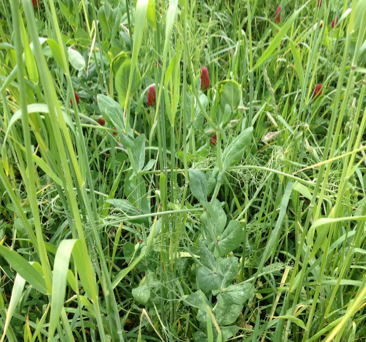Using Cover Crops for Grazing Cattle
 The use of cover crops prevents soil erosion, increases soil organic matter and microbial activity, improves soil water retention, recycles nutrients and decreases soil compaction. Cover crops also provide an excellent way to extend the grazing season. In Kentucky, commonly used cover crops for grazing include cereal rye, wheat, and annual ryegrass. Winter legumes such as crimson clover, hairy vetch, and winter peas can provide high quality forage for grazing. Legumes provide the additional benefit of nitrogen fixation. Brassicas, such as turnips, are high quality, deep rooted and grow in dry conditions.
The use of cover crops prevents soil erosion, increases soil organic matter and microbial activity, improves soil water retention, recycles nutrients and decreases soil compaction. Cover crops also provide an excellent way to extend the grazing season. In Kentucky, commonly used cover crops for grazing include cereal rye, wheat, and annual ryegrass. Winter legumes such as crimson clover, hairy vetch, and winter peas can provide high quality forage for grazing. Legumes provide the additional benefit of nitrogen fixation. Brassicas, such as turnips, are high quality, deep rooted and grow in dry conditions.
Cereal rye is a great choice for those needing fall and early spring grazing. Rye also has the advantage of growing under a wide range of soil conditions. Wheat produces less than rye in the fall but matures later in the spring, extending the grazing season well into April. Annual ryegrass is a great fall and winter cover crop to graze if planted in September to ensure establishment. It has an extensive root system that establishes well in almost all soils.
Brassicas makes excellent feed and produces highly digestible fiber. This highly digestible forage has a rapid rate of fermentation that can lead to a buildup of gas that may cause bloat. Using feed additives such as poloxalene or ionophores, as well as providing long stem roughage, can aid in the prevention of bloat.
Grazing can begin after cover crops grow six to eight inches tall for the grasses and above 10 inches for brassicas and legumes. Ideally, livestock should be moved twice weekly. A good option is to strip graze cover crops. With strip grazing, a set amount of forage is allocated at a time, which meets the needs of the livestock.
When grazing cover crops, do not overgraze an area, making sure to leave at least four inches of plant cover. Once animals have grazed an area to this height, cattle should be rotated to another area to optimize future regrowth. A good management practice is to observe the amount of ground cover frequently for overgrazing or undergrazing and adjust rotation of cattle accordingly. Application of grazing practices on cover crops can aid in the distribution of manure and increase soil organic matter. In order to reduce animal compaction, plan and utilize a sacrifice area during wet conditions.
Categories:
Winter
Extending the Grazing Season


